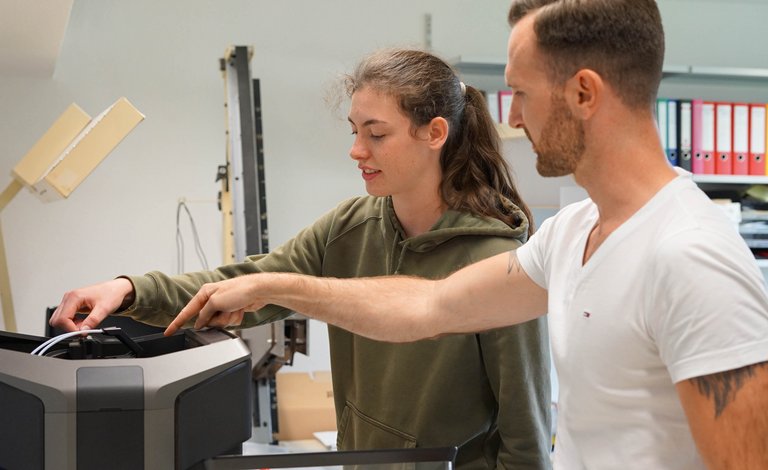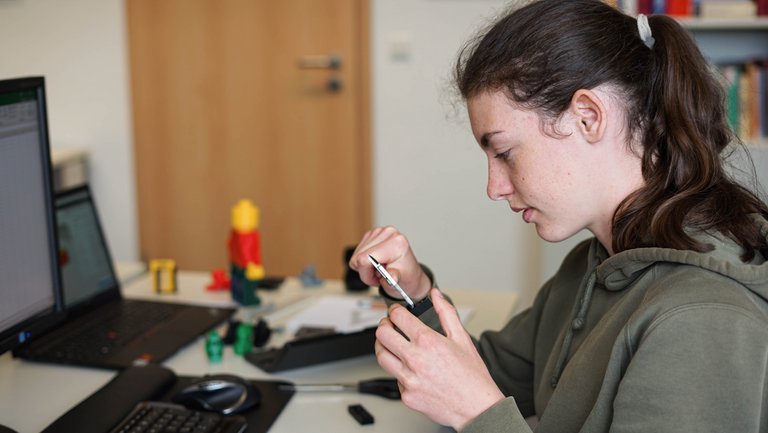How does 3D printing work? And what advantages does this sustainable technology offer compared other manufacturing processes? These were the questions that 17-year-old Ella dealt with during her internship at the Product and Systems Engineering Group under the direction of Prof. Stephan Husung and the supervision of Felix Röhnert. Within a week, the student was able to design and print her own components.
What does a mechanical engineer actually do? A student internship at the TU Ilmenau provides answers

According to a recent study by the Bertelsmann Foundation, young people with a high level of education in particular would like more advice on the transition from school to work. In addition to parents and teachers, internships and company contacts play a particularly important role in giving students a realistic picture of their future profession according to the study.
What do mechanical engineers, biomedical engineers, physicists or chemists actually do in their job? This question was also asked by several Year 10 students at secondary schools in Ilmenau. Shortly before the end of the last school year, they were given answers to these questions and insights into various specialist areas at the university during internships at TU Ilmenau.
One of them is Ella, a student at Ilmenau's State Secondary School "Am Lindenberg". Her one-week work placement at the Product and Systems Engineering Group was characterized by a tricky task, intensive exchange with the scientific and technical staff and joint visits to the canteen. The 17-year-old was inspired to apply to TU Ilmenau by a series of YouTube videos:
I follow a Youtuber who has done various projects with 3D printing, among other things. That got me excited and I just had a look at what you have to study to do something like that. That's when I came across mechanical engineering and the TU Ilmenau.
Sustainable and future-oriented technology in a wide range of industries

She was supervised by Felix Röhnert, a technical employee in the group, who also shared his office with the student: "As a supplement to traditional manufacturing processes, 3D printing as a so-called additive manufacturing process enables very individual and fast production in terms of preparation time: you are able to produce components on demand quickly and without a long lead time." The process also has many advantages in terms of sustainability, says Felix Röhnert:
Recycled materials can also be used for 3D printing. Furthermore, it is possible to use filaments made from materials with a proportion of renewable raw materials, such as wood. These are approaches to working with this technology in a sustainable and future-oriented manner in a wide range of industries - from the automotive industry to aerospace, medical technology and the consumer goods industry.
During her internship, Ella first learned the basics of product development and modern manufacturing methods. Felix Röhnert also introduced her to "additive thinking" and the methodology of parametric modeling with a 3D CAD system:
A CAD crash course, so to speak, of the kind that Bachelor's students in mechanical engineering, automotive engineering, mechatronics or industrial engineering and management receive in more detail in the first semester. Students learn the necessary "know-how" from us to create components, assemblies and drawing derivations and thus competently implement their own ideas in the future. In other words, we provide them with a kind of tool to help them solve design problems quickly and effectively. By simply taking Ella along to a seminar, she was able to get an idea of this and at the same time gain a small insight into everyday student life.

"It was great that I was then given the specific task of independently designing a component that could be used to check the standard settings in the printing process and improve them if necessary," says Ella. What could such a test piece look like? How big should it be? How big is it really after printing, i.e. by how much has it shrunk? And how should the settings and values in the software be adjusted accordingly? During her one-week-internshipt the student thought about these and similar questions.
To fulfill her task, she first drew a 2D sketch of the test sample by hand and then brought it into the third dimension in the form of a 3D model. She then converted the resulting 3D model into instructions for the printer using what is known as a slicer: "This software basically chops up the CAD model into layers so that the printer knows what to do," explains Ella. "For example, information on controlling the temperature, printing speed and number of fusion layers is written into a code that gives the printer the necessary instructions."
For the printing itself, Ella used what is known as fused deposition modeling (FDM), in which a plastic is heated and liquefied in a nozzle and then applied and cooled at certain points - in several layers.
"It was super exciting and great to see that the test piece I had designed actually came out in the end," says Ella:
It was definitely my best internship so far with great supervisors and colleagues, and it reinforced my idea of studying mechanical engineering.
Supervisor Felix Röhnert is also enthusiastic:
Ella has exactly the right prerequisites for studying engineering: An interest in exploring the world and creating something new. Our society needs young people like Ella who want to develop innovative and sustainable solutions for the complex challenges of the future.
More information about internship opportunities at the TU Ilmenau
What does an engineer actually do? Bachelor's students of engineering in their first semesters at TU Ilmenau also receive answers to this question. As part of orientation programs, they are given insights into research during company tours, lectures by graduates of various degree programs or by industry and business partners and can make initial contacts for a later career. In small teams, they also work on exciting cross-course projects and can take part in courses on key qualifications such as learning techniques, time management, scientific work, project management and self-management. |
Contact
Prof. Stephan Husung
Academic Dean at the Department of Mechanical Engineering and Head of Product and Systems Engineering

